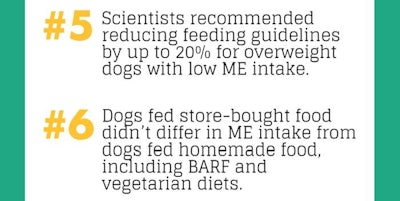
Particular types of dogs ate more metabolizable energy (ME) to maintain their body weights than others in a study of 586 pet dogs. Metabolizable energy is the amount of energy left for the body to use after digestion is complete. Pet food manufacturers can use this research to guide their formulation of lifestyle- and breed-specific dog foods.
Comparison of ME intakes
Overweight dogs tended to have lower ME intake than normal-weight dogs. On the other end of the scale, underweight dogs consumed more ME than normal-weight dogs. Intact male dogs had higher ME intakes than neutered males and both intact and spayed females. Older dogs has lower ME intake than younger dogs.
Certain aspects of dog food formulation didn’t seem to influence the subsequent ME intake of the dogs eating the food. Dogs fed store-bought food didn’t differ significantly in ME intake from dogs fed homemade food, including BARF and vegetarian diets.
Although there were differences among dog breeds’ ME intakes, the biology of each breed doesn’t completely explain these differences, study author Ellen Kienzle, PhD, chair of animal nutrition and dietetics at Ludwig-Maximillians University in Munich, Germany, told Petfood Industry.
In particular, active owners might choose breeds associated with an energetic lifestyle, she said. What’s more, certain dog breeds go in and out of fashion for particular lifestyles.
Adapting feeding guidelines using research results
Kienzle said that an important consequence of her research is that dog food nutrient profiles need to be adapted to the lower food intake of less active dogs.
Pet owners may be inclined to simply change the quantity of food they feed to dogs with different lifestyles. Instead, Kienzle suggested that dog food labels should contain a caveat about if a dog puts on or loses weight while eating the recommended amount of one formula. The labeling could inform consumers to change feeding quantity or switch to a different formula, such as active-lifestyle or weight-loss dog food formulations.
Based on the results of their ME intake research, dog food packaging could suggest reducing the recommended feeding quantity by up to 20 percent for obese dogs, wrote Kienzle and her co-authors in the Journal of Animal Physiology and Animal Nutrition.

















